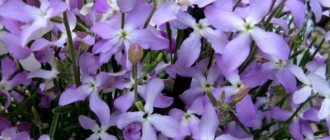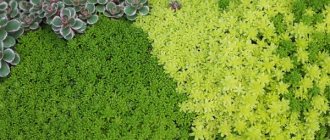Kotula - at a quick glance at this plant, you might at first think that we are contemplating a goose foot, growing along roads and in meadows. But such similarities are deceptive. Cotula's homeland is South America, so she is a foreigner. Found naturally in New Zealand and Southern Europe. Attracts attention with small dissected leaves, creeping stems and yellowish flowers.
In European countries, alpine hills with low-growing Cotula, which has creeping stems, are often found. The plant grows at high speed, forming natural green mats. Attractive in appearance, especially when flowers appear. Basically, a plant on a hill is used to create a beautiful soil cover so that empty spaces from faded plants are not visible.
Description and brief characteristics of the flower
The name comes from the Latin word "cotula". This is what they called a small vessel in ancient Rome. People call it Ladonnik. It belongs to herbaceous perennial plants and is planted exclusively in open ground. Belongs to the Astrov family. Capable of covering land, forming a dense, beautiful mat of bright green color. Prefers sandy or clay soils, as well as shallow water.
Often used in landscape design. They are used to plant lawns, decorate ponds and other artificial water formations, and decorate alpine slides. It can grow separately or be grown along with other plants. Able to decorate retaining walls, cracks between tiles, and slides.
The flowers are very low, not significantly higher than the height of the green mat itself. The leaves are outlined, pinnately dissected. On top of the leaves you can see small pale yellow or white flowers, which are of no particular value. However, among amateur gardeners this plant enjoys well-deserved popularity due to its unpretentiousness. Easy to grow and does not require special care. It is easily restored after trampling and can withstand temperature changes. Tolerates dry days and bright sunlight.
No matter how many rainy days there are in a year, Kotula will have enough of it. The plant should not be watered additionally. It also makes no sense to apply fertilizers, since the plant is suitable for poor soils, in which it thrives. Does not lack nutrients. Direct sunlight cannot harm the flower, since it is not afraid of burns. The plant is a light-loving plant, so there is no need to choose shaded places for the plant.
Helpful information. Kotula does not tolerate stagnant water well, so this point must be taken into account when choosing a permanent landing site and subsequent cultivation.
Varieties of palmetto
When decorating front gardens and flower beds, mainly the following types of Kotula are used:
| Rough | A landscaping element for many design projects. The plant looks good between ground slabs and on steps. Leaves are dark green. When the outside temperature drops, they take on a brownish-red hue. During the flowering period, small yellow flowers appear between the leaves, resembling balls in appearance. The flower heads reach 5mm in diameter. The plant is low-growing, does not exceed 5 cm in height. It develops both in partial shade and in open sun. Not afraid of winter frosts. Does not tolerate stagnant water well. |
| Coronopus-leaved | This type can be found more often. Grows up to 15 centimeters in height. The stems are covered with small pinnately dissected leaves. They sparkle in the sun. The peduncles are tall, and baskets are formed on them. Flowers appear in July and fade by September. It grows and develops both in partial shade and in open sun. It is advisable to plant in moist soil with medium or low fertility. Tolerates saline soil well. Prefers clay-sandy drained soil. The plant is classified as an annual. Reproduction options: seeds that fall into the ground in the same place. The appearance is unpretentious and is often used to cover formed voids. Gained popularity as lawn flowers. |
| Cream Bud | Practically no different from Koronopusolistnaya. The only difference is in the shade of the inflorescences. Cream Bud's are creamy. They are grown mainly in sunny areas or with some shade. Prefers soil with good drainage. |
| Bristly haired | Refers to perennial plants. High. Reaches a length of 12 centimeters. It was first discovered in natural conditions in South Africa. Visually similar to a rug of different density and height. The flowers look like hemispherical inflorescences, the diameter of which reaches 1.4 centimeters. They can grow both in partial shade and in constant sunlight. It blooms for two months: May – June. |
| Linear - bladed | A perennial plant used to create natural carpeting. It is considered tall of its kind, as it reaches a height of 150 mm. The leaves are small with numerous linear segments. Inflorescences up to 20 mm in diameter. The colors of the inflorescences are variegated: they can be yellow and bright red. |
| Lapchatnikovaya | Somewhat similar to Sherokhovataya. It came to us from New Zealand, where it preferred to grow in swampy areas. The palm tree reaches a height of 10 centimeters, while the leaves are small. Their length is about 4 centimeters. The stem is creeping, thin. There are no leaves on it. During the flowering period, you can observe small (up to 1 cm) yellow flowers. The olive green leaves are pinnate with rounded lobes. With the onset of autumn, their color changes to brown. Unlike other representatives, it prefers to grow in damp and shaded places. There are several methods of propagation: division, using cuttings, sowing. |
| Comb | The homeland of the plant is New Zealand. Almost never found in rock gardens. Flowering occurs over a long period of time. The first flowers appear in early June and delight the eye until late autumn. In autumn the inflorescences turn brown. Unlike other representatives, Kotula Comb is not particularly hardy, therefore it belongs to the category of especially ornamental plants. There are certain requirements for growing a flower: acidic sandy soil and the constant presence of sun on the site. Afraid of excessive rainfall and stagnant water. To ensure comfortable growing conditions, the resulting green mat is covered with crushed stone. |
History of Kotula
Kotula is a species known to mankind for quite a long time.
The famous botanist Carl Lynaeus described the first several varieties of this plant back in 1753. More than 100 years later, another botanist, George Bentham, began studying this plant. After a long time of analyzing the characteristics of the cotula, in 1867 he divided the species into 3 independent subspecies. The main classifier was the number of chromosomes. Thus, the first category includes the largest number of varieties - about 40. The number of chromosomes in its representatives is 8 and 10.
The second category included plants with 13 chromosomes. There were only 30 species.
The smallest number of cotula species fell into the third section. There are 8 varieties in total, each with 18 chromosomes. Later, this section was completely separated into a separate group on the initiative of David George Lloyd.
Reproduction methods
Several methods are used to propagate Cistus: using seed material or cuttings.
Use of seeds
Seed propagation should begin in late February - early March. First, seedlings are grown. Take a special container. It shouldn't be too high. The soil mixture is added to the container and the seeds are sown. The distance between the seeds should be at least two centimeters. The next layer is compost about 5 mm thick. The last layer is slightly pressed down with the palm of your hand and watered. The container is covered with plastic wrap and exposed to sunlight. The room temperature should be around +15 degrees. The seeds germinate quickly.
The first young shoots will hatch in 14–21 days. As soon as the sprouts reach a height of 7 centimeters, they can be transplanted to a permanent location. The seedlings are placed in open ground at the end of May. But before planting the sprouts in the ground, you need to take them out into the air for several days for 5 - 10 minutes for the purpose of hardening. Try to protect from strong gusts of wind. Within a year after planting, flowers will appear in the flowerbed.
If the climatic conditions are suitable (southern latitudes), then the seeds can be sown directly into the ground. To do this, choose May or June money. The interval between seeds should be at least 250 mm. The seeds are sprinkled with earth and lightly pressed down. Be sure to carry out constant watering.
Helpful information. Kotula seeds are covered with a special shell that protects them from exposure to high temperatures. If the temperature outside exceeds +35 degrees, then the stems of the plant may begin to release essential oils, which can lead to their combustion. The fire burns everything around, but does not touch the seeds that have fallen on the ground. Therefore, after a short time, Palm will restore its existence again, unlike other plants exposed to fire.
The resulting ash during combustion has a beneficial effect on fallen seeds, fertilizing them. But fire occurs only in hot climates. In our latitudes this is excluded.
Vegetative propagation method
Kotula can also reproduce vegetatively. To do this, take annual shoots and cut cuttings from them. They are first rooted and then grown in greenhouse conditions. Cuttings are harvested from September to October. Shoots with two buds (up to 8 centimeters) are selected. They are immediately planted in the ground and the soil is moistened. It is necessary to keep the air temperature around +15 degrees. As soon as the temperature drops below this limit (in winter), the planting is covered. With this method of propagation, rooting is good.
early thyme
Thyme or thyme is a perennial plant that can be useful not only for landscaping, but also as a seasoning and for making drinks, thanks to its unique aroma.
The shrub reaches a height of approximately 15 centimeters, has strong stems, fluffy foliage, and small, purple flowers. Often, so many inflorescences bloom that the leaves are almost invisible behind the flower carpet.
Preferred growing conditions: dry soil with good drainage. Does not tolerate high humidity well, but is resistant to prolonged droughts.
Growing rules
How to plant a flower? First, you need to choose the right permanent landing site for the Cistus. It must be illuminated. The soil cannot be dense. Air and water must pass through it freely. During the planting process, the soil is loosened.
You should not choose places for planting Kotula that can be flooded with melt water or are constantly exposed to soaking.
For Ladonnik, the composition of the soil does not play a big role. The main thing to pay attention to is the presence of good drainage. The plant grows quickly, so when it leaves the garden bed, the extra shoots should be eliminated.
Each variety prefers to grow in certain soils.
Why was the plant called that?
Kotula is the original scientific name of the plant. This is how it was originally named and is also translated into Latin. Although what it means in the original is unknown. A similar term is found in the Corsican language and is translated as “large pebbles.” Indeed, the large flowers of the groundcover cotula really look like a path of bright pebbles.
Kotula is popularly known as “golden buttons”. Most likely due to its disc-shaped inflorescences of a bright yellow-gold color.
Smooth herniator
This creeping ornamental plant of the carnation family has long creeping shoots, the length of which can reach 30 centimeters. The hernia grows best if it is not disturbed. Often used to decorate the sides of beds.
Depending on the lighting, the color of its leaves changes - in the sun they acquire a light yellowish-green tint, and in the shade they become rich emerald.
One of the most unpretentious plants, it copes well with lack of moisture and lack of light. However, it is worth remembering that the hernial moth cannot tolerate being in the vicinity of a large number of cereals. Loves sandy soils, tolerates winter cold well and does not need additional shelter.
Mazus repens
This is a low but graceful perennial, the length of the stems does not exceed 10 centimeters, with original and memorable lilac flowers, closely resembling small orchids.
Unpretentious, grows well both in the sun and in shaded areas.
For rapid growth and abundant flowering, it is better to plant it on fertile, well-drained soils, but it can also withstand fairly spartan conditions. Its weak point is harsh frosty winters, so it needs good shelter.
Bryozoan awl-shaped
Otherwise it is called Irish moss. In fact, this herbaceous plant is about 7-8 centimeters high, one of the most resistant to trampling - you can walk, run and jump on it without causing any damage.
Growing bryozoans will prevent any weeds from appearing on the lawn - this plant displaces them completely. Among other things, it does not require regular watering; additional moisture is required only in severe drought.
It grows very quickly, damaged areas on the lawn are very quickly covered again with new shoots. The flowers are small, light, give an interesting decorative effect and spread a sweet honey aroma.
Mühlenbeckia axillaria
A low shrub reaching approximately 20 centimeters. Its intertwined shoots form a continuous green carpet. Grows in sunlit areas of the garden and in partial shade. Loves good and abundant watering and is resistant to pests and diseases.
For good growth of green mass, periodic fertilizing with organic fertilizers and monitoring of watering will be required. It does not tolerate winter temperatures below 5 degrees below zero, so it is best to plant it in regions with warm winters or provide good shelter.
- Author: iarriba
Rate this article:
- 5
- 4
- 3
- 2
- 1
(5 votes, average: 4.8 out of 5)
Share with your friends!
Kinds
The Plant List database
, the genus includes 62 species:
- Cotula abyssinica Sch.Bip. ex A.Rich.
- Cotula alpina (Hook.f.) Hook.f.
- Cotula andreae (E.Phillips) K.Bremer & Humphries
- Cotula anthemoides L.
- Cotula aurea L.
- Cotula australis (Sieber ex Spreng.) Hook.f.
- Cotula barbata DC.
- Cotula bipinnata Thunb.
- Cotula bracteolata E.Mey. ex DC.
- Cotula burchellii DC.
- Cotula ceniifolia DC.
- Cotula chamaemelifolia Ehrenb. ex K.Koch
- Cotula cinereum Delile
- Cotula coronopifolia L.
- Cotula cotuloides (Steetz) Druce
- Cotula cryptocephala Sch.Bip. ex A.Rich.
- Cotula dielsii Muschl.
- Cotula duckittiae (L.Bolus) K.Bremer & Humphries
- Cotula eckloniana (DC.) Levyns
- Cotula elongata B.Vogel
- Cotula filifolia Thunb.
- Cotula goughensis RNRBr.
- Cotula gymnogyne F.Muell. ex Benth.
- Cotula hemisphaerica Wall. ex Benth. &Hook.f.
- Cotula heterocarpa DC.
- Cotula hispida (DC.) Harv.
- Cotula kotschii Benth. &Hook.f.
- Cotula laxa DC.
- Cotula leptalea DC.
- Cotula lineariloba (DC.) Hilliard
- Cotula loganii Hutch.
- Cotula macroglossa Bolus ex Schltr.
- Cotula mariae K.Bremer & Humphries
- Cotula melaleuca Bolus
- Cotula membranifolia Hilliard
- Cotula mexicana (DC.) Cabrera
- Cotula microglossa (DC.) O.Hoffm. & Kuntze ex Kuntze
- Cotula montana Compton
- Cotula moseleyi Hemsl.
- Cotula myriophylloides Harv.
- Cotula nigellifolia (DC.) K.Bremer & Humphries
- Cotula nudicaulis Thunb.
- Cotula paludosa Hilliard
- Cotula paradoxa Schinz
- Cotula pedicellata Compton
- Cotula pedunculata (Schltr.) E.Phillips
- Cotula pterocarpa DC.
- Cotula pusilla Thunb.
- Cotula radiata O.Hoffm. ex Kuntze
- Cotula radicalis (Killick & Claassen) Hilliard & B.L. Burtt
- Cotula rosea Less.
- Cotula sericea Lf
- Cotula socialis Hilliard
- Cotula sororia DC.
- Cotula squalida (Hook.f.) Hook.f.
- Cotula stenophylla K.Koch
- Cotula tenella E.Mey. ex DC.
- Cotula thunbergii Harv.
- Cotula turbinata L.
- Cotula villosa DC.
- Cotula vulgaris Levyns
- Cotula zeyheri Fenzl











